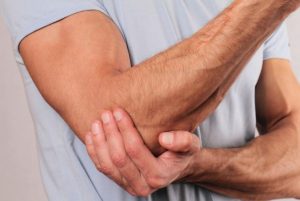The elbow is a versatile joint that allows you to lift, swing, throw, and more. The wide range of function means there are many different ways to hurt your elbow. Some injuries are one-time events, like when you fall or are hit during contact sports. Sprains, for example, commonly occur when ligaments are overstretched or torn. Elbow pain may also be the result of wear-and-tear injuries or disease, such as osteoarthritis or rheumatoid arthritis.
Why Does My Elbow Hurt?
Chronic elbow pain often develops due to overuse at the joint. It can show during certain activities, flare up over repetitive movements, or the elbow may consistently ache.
- Bursitis: The elbow bursa (olecranon bursa) is a fluid-filled sac that cushion your bones, muscles, and tendons. Infection or repetitive motions may irritate or damage the bursa, causing it to swell and become painful. People with physically demanding occupations, musicians, and athletes are prone to bursitis. Although common activities such as gardening, painting, and shoveling can also lead to bursitis. Most cases of elbow bursitis (non-infectious cases) are treated at home over three to six weeks with rest, over-the-counter non-steroidal anti-inflammatory drugs (NSAID’s), and joint immobilization.
- Stress fracture: a small crack in one of your bones. Athletes who throw often, such as baseball pitchers, can experience stress fracture of the elbow because of the repetitive movements.
- Osteoarthritis (OA): commonly the result of “wear-and-tear” on the joint or prior traumatic injury, osteoarthritis causes pain and stiffness in the elbow when the cartilage wears down and bone rubs against bone. Symptoms may include bone spurs, joint instability, reduced range of motion. The elbow is one of the joints less likely to be affected by osteoarthritis because the ligaments in the elbow are able to stabilize the joint better than some other joints in the body, like the knees and hips. Non-surgical treatments of OA in the elbow may include activity restriction, over-the-counter or prescription pain medications, and physical therapy.
- Rheumatoid Arthritis (RA): the most common type of arthritis in the elbow. Most people are familiar with the idea that rheumatoid nodules affect the fingers, but did you know they can also develop on the tips of your elbows? RA causes elbow instability, pain, and difficulty bending or straightening the elbow.
- Tennis elbow: inflammation of the tendons of your forearm muscles where they attach to a bony bump on the outside of your elbow.
- Golfer’s elbow (medial epicondylitis): a form of tendonitis that causes pain and inflammation of the tendons that connect the forearm and elbow. Golfer’s elbow can affect flexion and rotation of the wrist and forearm. Symptoms usually start as a minor pain or tenderness on the inner elbow. As symptoms progress, pain may radiate up and down the arm.
When to See a Doctor
If you think you have dislocated or fractured your elbow, go to the nearest emergency room or orthopedic urgent care center.
You should also see a doctor if:
- Elbow pain persists after at-home treatments (rice, ice, NSAID’s), or pain the is present even when you’re not actively using your arm
- You experience pain, redness, or swelling of the joint accompanied by fever
- You experience swelling, bruising, and intense pain around your elbow
- Your range of motion is limited due to pain or swelling of the elbow
Comprehensive Elbow Care at Raleigh Orthopaedic Clinic
The Raleigh Orthopaedic elbow surgeons work closely with our on-site Certified Hand Therapists to treat a wide range of elbow injuries and conditions. When you trust the experts at Raleigh Orthopaedic to be your official orthopedic provider, you will be met with the highest quality care in Wake County. Contact us today to schedule an appointment at one of our convenient locations.
The material contained on this site is for informational purposes only and DOES NOT CONSTITUTE THE PROVIDING OF MEDICAL ADVICE, and is not intended to be a substitute for independent professional medical judgment, advice, diagnosis, or treatment. Always seek the advice of your physician or other qualified healthcare providers with any questions or concerns you may have regarding your health.
